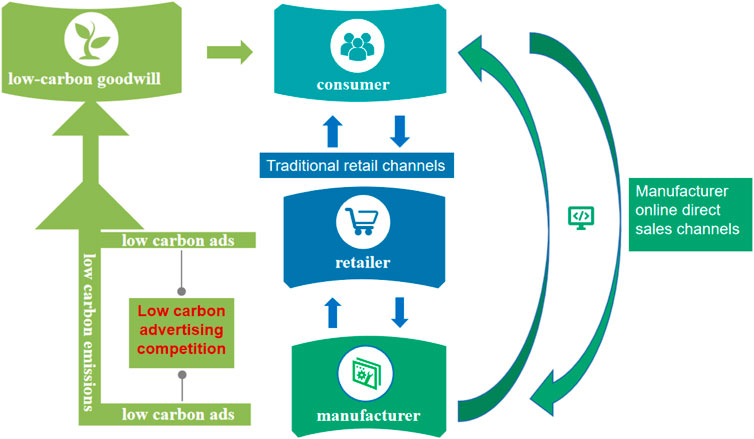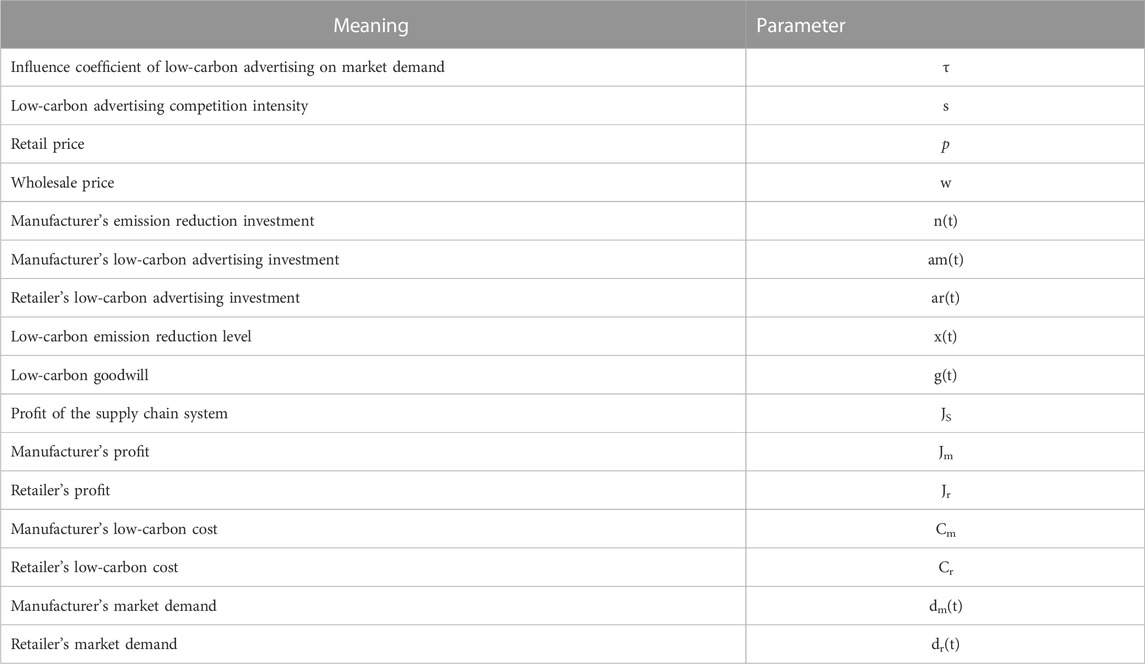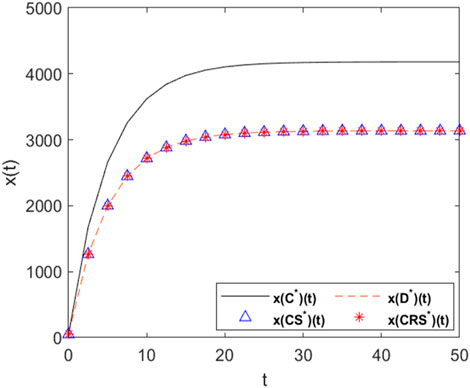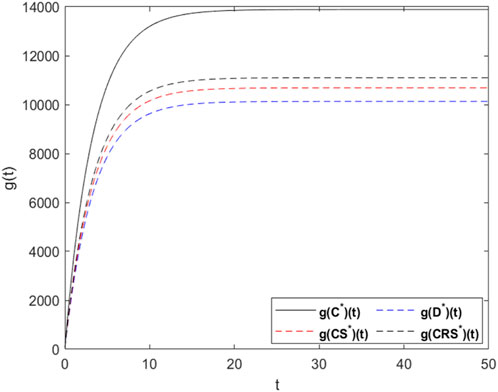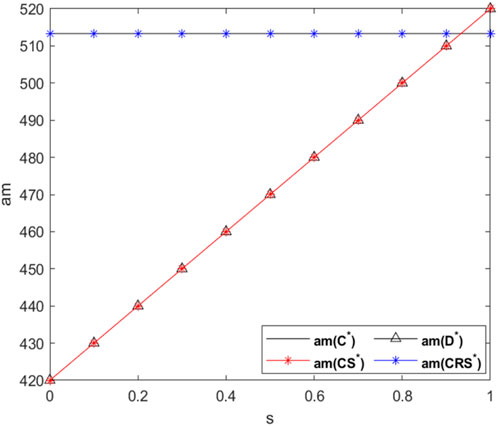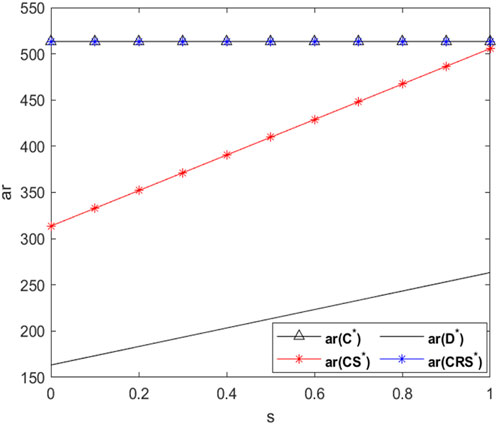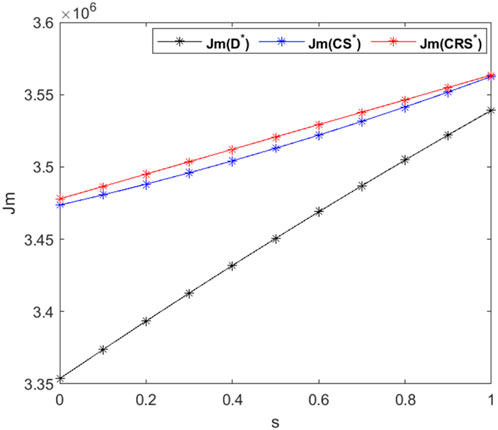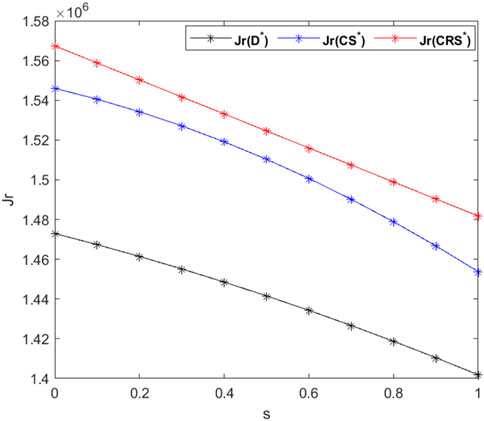- 1School of Economics and Management, Southwest University of Science and Technology (SWUST), Mianyang, China
- 2Sichuan Tianfu New Area Innovation Research Institute, Southwest University of Science and Technology (SWUST), Chengdu, China
Introduction: Under the dual opportunities of low-carbon consumption preference and online consumption platforms, vendors’ low-carbon advertising incursions provide opportunities for decarbonization and market position enhancement, as well as further research on the value of low-carbon advertising. This study aims to explore the contractual choices of green vendors’ online channels participating in low-carbon advertising competition under the low-carbon goodwill effect, and to simulate and evaluate the contractual choices of supply chain members.
Methods: Using differential games, through the innovative application of the traditional low-carbon goodwill model and the introduction of the low-carbon advertising competition intensity coefficient, we design one-way and two-way cost-sharing contracts under low-carbon competition, coordinate the vicious competition in the supply chain, and provide contractual choices for supply chain participants.
Results and discussion: Under the low-carbon advertising competition decision, the manufacturer has an absolute low-carbon market advantage, but the interests of all supply chain members are weakened, and interestingly, the manufacturer, who dominates the market, is the facilitator of the contractual agreement. Second, well-designed pacts can provide manufacturers and traders with more options for low-carbon strategies. Although both one-way and two-way cost-sharing pacts can generate Pareto gains for the supply chain and its members in advertising competition, two-way cost-sharing pacts are superior to one-way pacts in terms of coordination advantages. In addition, an important finding is that greater profit growth can be achieved through contractual cooperation in low-intensity advertising competition. Thus, moderate competition is desirable, while excessive competition can harm the supply chain system. Manufacturers should actively urge retailers to cooperate in order to optimize profits and establish long-term stable partnerships between upstream and downstream firms in green supply chains.
1 Introduction
The year 2022 marks the 50th anniversary of the United Nations Environment Programme (UNEP), which recognizes that current global low-carbon efforts face enormous challenges and that more needs to be achieved by all countries (United Nations Environment Programme, 2022; Yang et al., 2023). At the Stockholm+50 conference in 2022, hundreds of speakers encouraged governments to make serious commitments to global environmental issues (Willetts, 2022). Serious global climate issues are also affecting people’s consumer choices, and in 2021, Euromonitor published a report on the “Top 10 Global Consumer Trends,” showing that approximately 65% of consumers worldwide are concerned about “climate change” and are placing greater emphasis on environmentally friendly actions (Yi et al., 2022). A large number of enterprises have joined the ranks of low-carbon emission reduction, focusing on low-carbon transformation, helping brands upgrade their green industrial chain and seize the dominant position in green and low-carbon development (Roh et al., 2022). Meanwhile, affected by COVID-19, global e-commerce sales are expected to increase by 38% year-on-year in 2019–2020. Due to the impact of the epidemic on consumption patterns, consumers are gradually shifting from offline consumption to online marketing channels.
Consumers’ climate awareness and the impact of the pneumonia epidemic have directly prompted green supply chain enterprises to implement targeted measures (Sarti et al., 2018; Camilleri et al., 2019). Many enterprises and supply chain members have focused on low-carbon transformation to help brands upgrade their green industry chain and seize the first opportunity for green and low-carbon development. For example, IKEA launched its global sustainability strategy “Benefit People, Benefit the Planet” in 2012 and continues to prioritize the harmonious development of people and the environment under this policy. In 2022, Kao ESG released the Kao (China) ESG Vision: Kao (China) ESG Vision: “Walking with Beauty, Living with the Environment.” Kao (China) ESG Vision: “Living with Beauty.”
Typically, supply chain partners steadily increase their goods’ low-carbon goodwill through manufacturing and marketing campaigns to promote customers’ purchase behavior (Ghosh and Shah, 2015; Hong and Guo, 2019). Clearly, realizing a low-carbon green supply chain is dependent not only on the degree of decarbonization at the production end but also on the amount of decarbonization at the consuming end. It is a highly plausible scenario for green manufacturers to use direct marketing channels for low-carbon marketing in low-carbon supply chain practices to boost their goods’ low-carbon goodwill and market competitiveness.
As a result, whether manufacturers choose to enter the low-carbon advertising competition market is advantageous to them, whether it is conducive to increasing brand low-carbon goodwill, and whether the supply chain under low-carbon competition has the best choice of low-carbon contract have become important issues. Therefore, studying the low-carbon channel advertising competition scenarios of green producers and retailers in the context of a low-carbon economy is critical. The purpose of this research is to analyze the best contractual options and run simulations in the competitive supply chain of low-carbon advertising penetrated by green manufacturers’ internet direct marketing channels.
Four models were designed in this study with the aim of answering the following questions:
(1) How do the low-carbon goodwill and low-carbon emission reduction characteristics of green manufacturers change in low-carbon advertising competition between green manufacturers and retailers?
(2) How does the intensity of low-carbon advertising competition affect supply chain members’ market demand and supply chain optimization decisions?
(3) Who are the supply chain members with market advantages in low-carbon advertising competition?
(4) Can uni- and bi-directional cost-sharing contracts achieve Pareto improvement or optimization in supply chain coordination under low-carbon advertising competition? Who benefits more as a supply chain member under the contractual co-ordination model? Which coordination contract strategy will supply chain members choose in competition?
Finally, the remainder of the paper is organized as follows: a review of related literature and relevant hypotheses and symbol interpretation are given in Section 2; modeling of supply chain decision-making results under the centralized and decentralized modes of low-carbon advertisement competition is given in Section 3; designing uni- and bi-directional cost-sharing contracts for coordinating vicious competition in the supply chain is discussed in Section 4; simulation analysis for validation is given in Section 5; and finally, some conclusions are drawn in Section 6.
2 Literature review
The relevant literature covers three aspects: the application of low-carbon goodwill, advertising competition in the supply chain, and low-carbon advertising coordination strategies.
2.1 The application of low-carbon goodwill
Consumers define the low-carbon behaviors of supply chain members as low-carbon supply chains are deployed, which will affect their low-carbon purchasing habits. Among these, brand goodwill has the greatest influence on customer behavior. Goodwill was initially presented as a new supply chain tool, culminating in the renowned Nerlove–Arrow model of advertising investment, in which Nerlove and Arrow asserted that advertising is a direct way of promoting goodwill (Nerlove and Arrow, 1962). The traditional goodwill model is still employed in multifactor dynamic variable modeling in supply chain studies. In current research, the typical goodwill model is conducted as a state variable to investigate the impact of consumers’ low-carbon preferences on revenue in a low-carbon supply chain, with the goodwill model primarily consisting of two dynamic variables: manufacturers’ low-carbon emission reduction efforts and retailers’ low-carbon advertising efforts (Zhou and Ye, 2018; Kang et al., 2019; Liu and Xu, 2022). There are numerous other applications for goodwill modeling; for example, Liang and Li. (2020) and Zhang et al. (2021) developed a low-carbon goodwill model for multiple retailers’ low-carbon advertising efforts in a dual-channel study to consider the effects of consumer reference to low-carbon effects and product low-carbon goodwill on purchases in a dual-channel supply chain. Furthermore, scholars have used low-carbon goodwill to low-carbon tourist supply networks, such as presenting low-carbon goodwill during crisis situations and utilizing big data to investigate the long-term operation of low-carbon tourism supply chains (Ma et al., 2020; Zhang et al., 2021). Furthermore, goodwill models are utilized to describe risk contingency production efforts in supply chain risk contingency research (Wu et al., 2022a). However, in this work, we will improve the classical goodwill model based on the manufacturer’s low-carbon advertising competition context.
2.2 Advertising competition in the supply chain
In supply chain advertising competition, more research has been conducted on advertising competition between manufacturers and between retailers; for example, Zhang et al. (2020) found that advertising competition between manufacturers may be more beneficial than price competition between retailers for the same product. Chang et al. (2021) and Zhong et al. (2022) considered advertising competition between retailers and examined how retailers should choose control strategies to gain an advantage in competition. Unusually, Wu et al. (2022b) argued that the manufacturer can act as a coordinator between two competing retailers to facilitate the marketing efforts of both. A small number of scholars have also studied the issue of advertising competition between manufacturers and retailers; for example, Karray and Herran., (2021) studied the retailer’s shop brand competing with the manufacturer’s national brand. Karle et al. (2020) studied the competitive marketplace between third-party platforms and retailers. Zhang et al. (2021) studied the strategic interaction between the manufacturer’s brand advertising infringement and the retailer’s introduction of PSB and SB.
2.3 Low-carbon advertising coordination strategies
Advertising cooperation is an important tool for coordinating manufacturers’ and retailers’ decisions. Berger (1973) first defined an advertising cooperation model with the participation rate as a manufacturer’s decision variable. Zhou et al. (2016), Chutani and Sethi, (2018), Yu et al. (2020), and Sarkar et al. (2020) investigated manufacturers’ and retailers’ dynamic collaborative advertising decisions to optimize low-carbon supply chain management and improve supply chain performance by providing retailers with different levels of advertising support. Xiao et al. (2019) and Xiang and Xu, (2019) studied advertising coordination strategies in a dual-channel supply chain. He et al. (2020) considered three low-carbon suppliers and integrators in the context of corporate social responsibility and three low-carbon cost-sharing strategies for cooperation. Huang (2023) studied low-carbon advertising cooperation strategies between a manufacturer and two retailers, demonstrating the impact of joint promotion on emission reduction and performance.
According to the examination of literature, the creation of low-carbon supply chains has attracted wide attention from researchers both at home and abroad, and research in this area has yielded rich results that are of significant guiding value to company practice. However, with the ongoing growth of the low-carbon supply chain, there are still many gaps, and this paper intends to start from the following points:
(1) From the literature combing, it is found that few scholars have considered the participation of manufacturers’ direct sales channels in low-carbon advertising competition, ignoring the positioning of manufacturers’ roles in low-carbon supply chains; second, for the composition of low-carbon goodwill, the low-carbon goodwill model under the low-carbon advertisement competition between manufacturers and retailers can be expanded and innovated on the basis of the traditional goodwill model. Therefore, this paper considers the aforementioned two cases at the same time and explores the changing characteristics of low-carbon goodwill and low-carbon emission reduction level under low-carbon advertising competition as well as the coordination contract under low-carbon competition.
(2) In terms of the supply chain contract strategy, while some scholars have conducted study on the cooperation of low-carbon supply chain members, the majority of the scholars have not studied the coordination contract in the context of low-carbon competitiveness. Second, the majority of the compacts are single cost-sharing compacts for low-carbon emission reduction and low-carbon advertisement; however, research on the feasibility of considering bi-directional cost-sharing compacts under low-carbon advertisement competition is insufficient. Therefore, the proposal of this contract stands in a new theoretical perspective and realistic situation perspective.
Therefore, this paper explores the coordination contract of manufacturer’s invasion of low-carbon advertising campaigns under the influence of low-carbon goodwill and extends the traditional low-carbon goodwill model to reflect manufacturer’s low-carbon participation; second, the low-carbon advertising competition between manufacturers and retailers is taken into account in the establishment of the market demand model, and the low-carbon advertising competition intensity coefficient is introduced. We explore the equilibrium strategy of supply chain members in the competitive situation, investigate the coordination mechanism of advertising competition and cooperation contract, and try to realize a breakthrough in both theoretical innovation and practical applications.
3 Underlying models and assumptions
3.1 Problem assumptions and symbol descriptions
This paper investigates a supply chain system consisting of a manufacturer and a traditional retailer with dual online and offline channels. In the context of the global low-carbon goal, the manufacturer carries out low-carbon production and sells through both the traditional retail channel and the online direct sales channel. During the production process, manufacturers engage in low-carbon emission reduction activities; during the sales process, manufacturers and retailers engage in low-carbon advertising, and there is a competitive relationship between the two in terms of low-carbon advertising. As a result, the level of low-carbon goodwill of a product is conferred by the manufacturer’s low-carbon emission-reducing production in the production process and the manufacturer’s and retailer’s low-carbon advertising campaigns in the sales process. The underlying model analysis in this section includes a centralized approach without competition (denoted by superscript C) and a decentralized approach with low-carbon competition (denoted by superscript D). The supply chain system is shown in Figure 1. The main symbols are explained as shown in Table 1.
Assumption 1. In the low-carbon emission reduction production chain, the level of emission reduction achieved by the manufacturer is determined by their investment in emission reduction technology in their manufacturing processes. However, as equipment ages and technology is updated, emission reduction technology will deteriorate. As a result, the dynamic change process of the product’s low-carbon emission reduction level in this paper is as follows, referring to the Zhou and Ye (2018) model of product’s low-carbon emission reduction level:
where
Assumption 2. In addition to the conventional goodwill model based on Nerlove-Arrow (1962), this article refers to the competitive goodwill model of He et al. (2021). Based on the case of the manufacturer’s direct sales channel advertising intrusion in this paper, it is defined that the low-carbon goodwill model of this paper consists of the manufacturer’s and retailer’s low-carbon advertising inputs as well as the manufacturer’s level of low-carbon emission reduction together, and the process of the low-carbon goodwill change in this paper is as follows:
where
Assumption 3. Referring to Prasad and Sethi (2004) and Zaccour (2008) cost function models, the low-carbon cost of supply chain members is a quadratic function of emission reduction and advertising inputs. Furthermore, in accordance with Giovanni’s (2010) study, the manufacturing and retailing costs are normalized to zero to simplify the modeling. In this paper, the low-carbon cost function of supply chain members is expressed as follows:
where
Assumption 4. Referring to Kopalle and Winer (1996), the demand function for low-carbon products is a linear function. In addition, with reference to Chen et al. (2017) and Martín-Herrán and Sigue (2017), pricing is carried out without considering the effect of price changes and assuming that manufacturers adopt a uniform pricing strategy. The prices of both direct sales and traditional retail channels of manufacturers are p. Based on the aforementioned assumptions, the demand function in this paper is as follows:
where η is the impact coefficient of the emission reduction level on market demand, η > 0; γ is the impact coefficient of low-carbon goodwill on market demand, γ > 0; s is the competition intensity coefficient of low-carbon advertising between the manufacturer and retailer, s > 0; τ is the impact coefficient of low-carbon advertising on market demand, τ > 0; and
Assumption 5. In an unlimited time range, manufacturers and retailers present the same discount rate ρ,ρ > 0. The objective function of manufacturers and retailers indicates that the goal of manufacturers and retailers is to maximize profits in an infinite time interval. The long-term profit function expression of manufacturers, retailers, and supply chain systems are as follows:
3.2 Centralized decision model (C)
In the centralized decision model, the manufacturer and retailer make decisions with the objective of maximizing the profit of the supply chain. Therefore, the objective function of the low-carbon supply chain system in centralized decision-making is as follows:
Proposition 1. The equilibrium results of the differential game under the centralized decision-making model are as follows:
where
Corollary 1.
Corollary 1 suggests that when consumers have higher brand preferences (
3.3 Low-carbon advertising competition model (D)
Under the centralized decision model, it is difficult for members in the actual supply chain system to reach a unanimous goal, and low-carbon competition among members is common; thus, in the low-carbon advertising competition decision, both manufacturers and retailers take their own interests as decision goals. Manufacturers and retailers are on equal footing under this ruling, and they play a Nash differential game. The game sequence is such that both the manufacturer and the store set their own choice variables in order to maximize their own earnings. Then, under the decentralized decision of competition without contract, the goal function is as follows:
Proposition 2. The equilibrium results of the differential game under the low-carbon advertising competition model are as follows:
where
Corollary 2.
According to Corollary 2, in the low-carbon advertising competition model, the intensity of low-carbon advertising competition between the manufacturer and retailer has a positive effect on low-carbon advertising investment, and obviously, the more intense the advertising competition between the manufacturer and retailer, the more they are stimulated to invest in advertising. The effects of other influencing factors on the equilibrium strategy are consistent with Corollary 1.
Corollary 3. A comparison of low-carbon decisions of supply chain members under centralized and competitive models is as follows:
(1)
According to Corollary 3, the level of emission reduction and low-carbon reduction achieved by the manufacturer in the competitive decision is lower than that in the centralized decision; retailer’s low-carbon advertising and promotion investment is lower than that in the centralized decision. However, when the level of advertising competition is low, manufacturer’s advertising investment in the centralized decision is greater than that in the competitive decision; when advertising rivalry is fierce, the competitive decision’s advertising investment will be bigger than that of the centralized decision. It indicates that when there is intense competition in low-carbon advertising, the manufacturer is more willing to invest in advertising costs, and according to the competition model, the more the manufacturer invest in low-carbon advertising, the greater the positive impact on profits and market demand.
4 Design of the cost-sharing contractual model
According to the underlying models, centralized decision-making can help the low-carbon supply chain achieve higher returns. However, in the actual low-carbon supply chain operation process, members are usually independent individuals, and decentralized decision-making with the goal of maximizing their own profits is the most common choice; however, it is difficult to achieve good returns in decision-making with the goal of maximizing decision-making. As a result, achieving the sustainable development of low-carbon competitive supply chains necessitates the full cooperation of both upstream and downstream supply chains. In this section, we will investigate the coordination strategy for the sustainable development of low-carbon competitive supply chains by designing two types of cost-sharing contract mechanisms.
4.1 Low-carbon cooperation uni-directional cost-sharing contract model (CS)
In the uni-directional cost-sharing contract model, considering the absolute advantage of the manufacturer in the low-carbon competitive market and the sustainable development of the supply chain system, the manufacturer is designed to share a certain amount of low-carbon advertising costs for the retailer, so as to promote the retailer’s market motivation, with a sharing ratio of
Proposition 3. The equilibrium results of the differential game under the uni-directional cost-sharing contract model are as follows:
where
Corollary 4. A comparison of low-carbon decisions of supply chain members under centralized, competitive, and uni-directional cost-sharing contract models is as follows:
(1)
According to Corollary 4, the retailer’s low-carbon advertising input in the uni-directional cost-sharing contract is larger than that in the competitive decision-making model and smaller than that in the centralized decision-making model. It can be seen that the uni-directional cost-sharing contract can promote retailers’ low-carbon advertising inputs. However, when the degree of advertising competition is low, the manufacturer’s advertising input in the centralized decision is greater than that in the uni-directional cost-sharing contract, and the advertising input in the uni-directional cost-sharing contract is equal to that in the competitive decision. When advertising competition is high, advertising inputs under the uni-directional cost-sharing contract and the competitive decision are equal and greater than those under the centralized decision. It is illustrated that due to the manufacturer’s market advantage in low-carbon competition, the manufacturer will not reduce the competitive trend of low-carbon advertising due to the cost-sharing contract because the low-carbon advertising inputs can bring more benefits to it compared to the low-carbon emission reduction inputs. In the following section, a bi-directional cost-sharing contract is introduced to further enhance the coordination contract.
4.2 Low-carbon cooperation bi-directional cost-sharing contract model (CRS)
This subsection builds on the uni-directional cost-sharing contract to create a bi-directional cost-sharing contract. Under the bi-directional cost-sharing contract, low-carbon advertising inputs are shared with each other in the interest of the entire coalition. In this case, the advertising cost-sharing rate shared by the manufacturer for the retailer is λ (0 ≤ λ ≤ 1), and the advertising cost-sharing rate shared by the retailer for the manufacturer is μ (0 ≤ μ ≤ 1). In the model and results of the advertising cooperative cost-sharing contract, the superscript is CRS, and the objective functions of the manufacturer and the retailer are expressed as follows:
Proposition 4. The equilibrium results of the differential game under the bi-directional cost-sharing contract model are as follows:
where
The profit comparison of supply chain members and systems under competitive versus cost-sharing decisions is complex and cannot be explained by deductive analytical formulas. Therefore, this paper will show part of it in the arithmetic analysis.
Corollary 5. A comparison of the low-carbon decisions of supply chain members under centralized, competitive, uni-directional cost-sharing, and bi-directional cost-sharing contract models is as follows:
(1)
According to Corollary 5, the manufacturer’s low-carbon abatement efforts are not improved in either the bi-directional cost-sharing contract or the uni-directional cost-sharing contract because the manufacturer’s share of abatement costs is not considered in the cost-sharing contract. The retailer’s low-carbon advertising input in the bi-directional cost-sharing contract is equal to that in the centralized decision-making, which proves that the bi-directional cost-sharing contract promotes the retailer’s low-carbon advertising input better than the uni-directional cost-sharing contract, reflecting the effectiveness of the bi-directional cost-sharing contract. At the same time, under certain conditions, the manufacturer’s low-carbon advertising input can also reach the same level of centralized decision-making under the bi-directional cost-sharing contract.
5 Numerical analysis
Through the mathematical calculation of the model in the previous two sections, this section will further validate the supply chain decision-making under low-carbon competition and the coordination effect of the two types of contracts by analyzing numerical examples, mainly investigating the effects of the key parameter coefficients, s and
5.1 Change characteristics of the low-carbon emission reduction level and low-carbon goodwill
The results in Figures 2, 3 show that the emission reduction level trajectory and the low-carbon goodwill trajectory are monotonic, cumulative state variables, and both the emission reduction level trajectory and the low-carbon goodwill trajectory converge to a steady state as they approach infinity. Second, the low-carbon goodwill and emission reduction levels in the centralized decision model are higher than those in the low-carbon advertising competition model, which indicates that the low-carbon emission reduction levels and low-carbon goodwill levels of the supply chain are compromised in the low-carbon competition scenario. Meanwhile, the low-carbon goodwill levels in the uni- and bi-directional cost-sharing contract are higher than those in the low-carbon advertising competition model, which indicates the effectiveness of the contract.
5.2 Changes in low-carbon advertising investment under competition
The results in Figures 4, 5 show that the advertising inputs of manufacturers and retailers increase with the degree of competition in the low-carbon advertising competition model and the decision of uni-directional cost-sharing contract. Uni-directional cost-sharing contracts can boost retailers’ low-carbon advertising efforts. Under the bi-directional cost-sharing contract decision, the vicious competition between the two parties in the low-carbon advertising input can be eliminated, and the low-carbon advertising input decision is equal to the centralized decision under the bi-directional cost-sharing contract. Meanwhile, the numerical analysis also further supports the conclusion of Corollary 5.
5.3 Changes in market demand under competition
According to Figures 6A, B, it can be seen that both manufacturers and retailers are able to realize the increase in market demand in uni-directional and bi-directional cost-sharing contracts. According to the results in Figure 7, the low-carbon advertising competition model (a) increases the market demand of the manufacturer while decreasing the market demand of the retailer, and the manufacturer has an absolute market advantage in the low-carbon advertising competition. Under a uni-directional cost-sharing contract, both the manufacturer’s and retailer’s market demand increases, and in the case of low-advertising competition intensity (b), the retailer briefly establishes market dominance, but the manufacturer regains full market dominance when advertising competition intensity increases. Finally, the bi-directional cost-sharing contract (c) generates more stable and higher market demand for both the manufacturer and the retailer than the low-carbon advertising competition model, demonstrating the coordinated effect of the bi-directional cost-sharing contract.
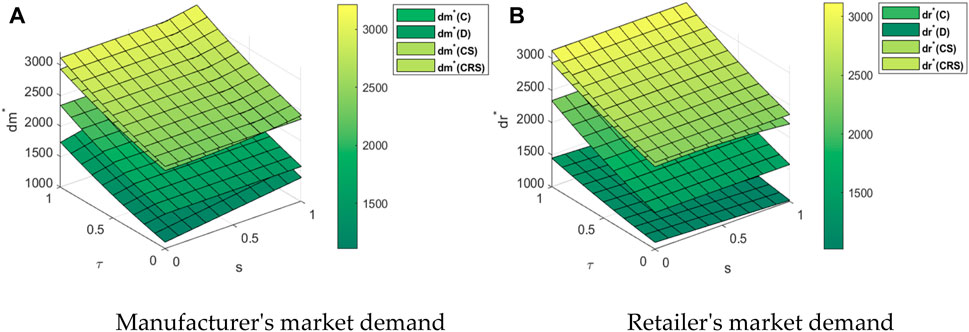
FIGURE 6. Comparison of market demand under four models of low-carbon competition. (A) Manufacturer’s market demand. (B) Retailer’s market demand.
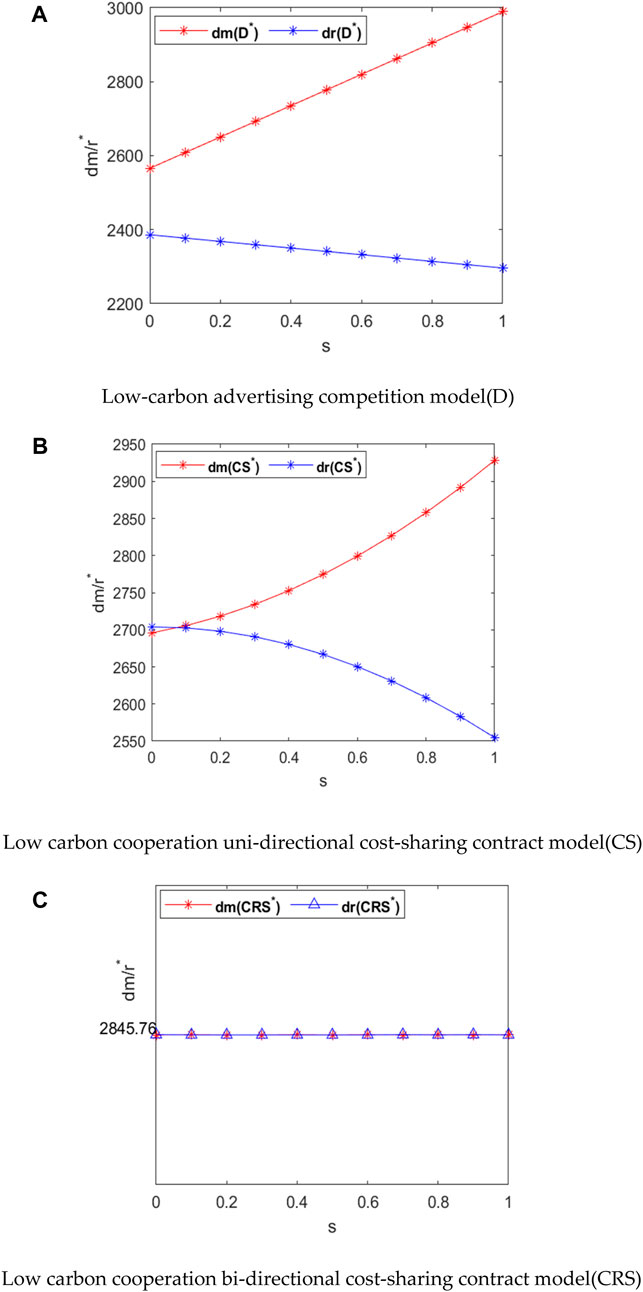
FIGURE 7. Changes in market demand under low-carbon advertising competition. (A) Low-carbon advertising competition model (D). (B) Low-carbon cooperation uni-directional cost-sharing contract model (CS). (C) Low-carbon cooperation bi-directional cost-sharing contract model (CRS).
5.4 Changes in profits under competition
Figures 8, 9 illustrate how uni-directional and bi-directional cost-sharing contracts can be used to harmonize competitive low-carbon advertising conflicts among supply chain participants, increase the profitability of supply chain members, and achieve Pareto improvements (
The results in Figures 10A, B show that the incremental profits of both the manufacturer and the retailer are greater than zero under both contractual coordination models and that the incremental profits of both the manufacturer and the retailer are greater than those of the uni-directional cost-sharing contract under the bi-directional cost-sharing contract, which implies that the bi-directional cost-sharing contract is more favorable and leads to contractual cooperation between the two parties. In addition, from the analysis of Figures 10C, D, the manufacturer and retailer can gain more by reaching a contract in low-intensity competition; therefore, manufacturers who like competition need to be reminded that they should not be greedy for competition in low-carbon advertising competition. Appropriate, healthy competition is a good medicine to promote the market, but excessive competition will bring about a greater chain reaction, and manufacturers should actively encourage the retailers to cooperate together in order to realize cooperation in low-intensity advertising competition. Retailers should actively encourage retailers to cooperate together in order to maximize the profit of cooperation and realize the long-term and stable cooperative relationship between upstream and downstream enterprises in the green supply chain, which is conducive to the long-term and stable development of the green supply chain.
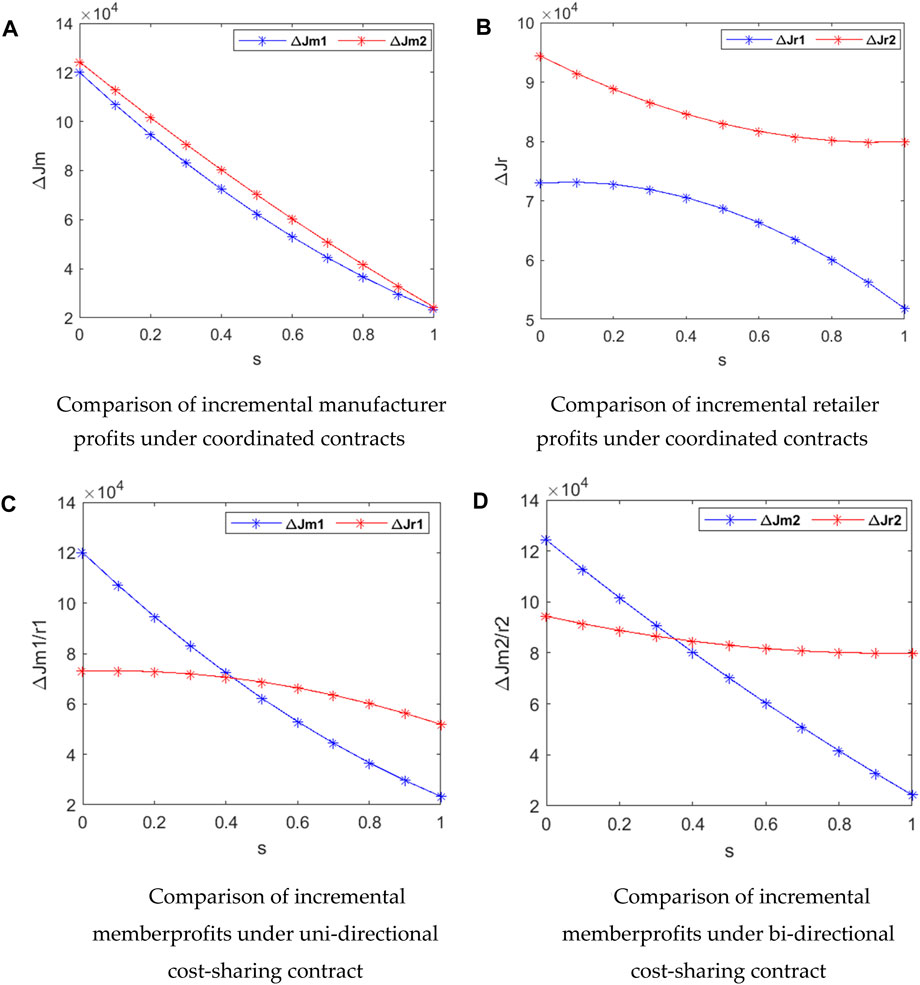
FIGURE 10. Comparison of profit increments of supply chain members under two coordination contracts. (A) Comparison of incremental manufacturer profits under coordinated contracts. (B) Comparison of incremental retailer profits under coordinated contracts. (C) Comparison of incremental member profits under uni-directional cost-sharing contracts. (D) Comparison of incremental member profits under bi-directional cost-sharing contracts.
5.5 The impact of low-carbon preferences (η) and brand preferences (γ) on markets and profits under competition
According to Figure 11, in the competitive market, the demand and profit of manufacturers and retailers increase with the coefficients of low-carbon preference (η) and brand preference (γ), where the effect of brand preference is greater than that of low-carbon preference, and thus there is a scenario in which manufacturers compete greedily in low-carbon advertising competition; at the same time, in the scenario of decentralized low-carbon advertising competition, the demand and profit of manufacturers are greater than those of retailers, and it also shows that the manufacturers have an advantageous decision-making position in the low-carbon competition.
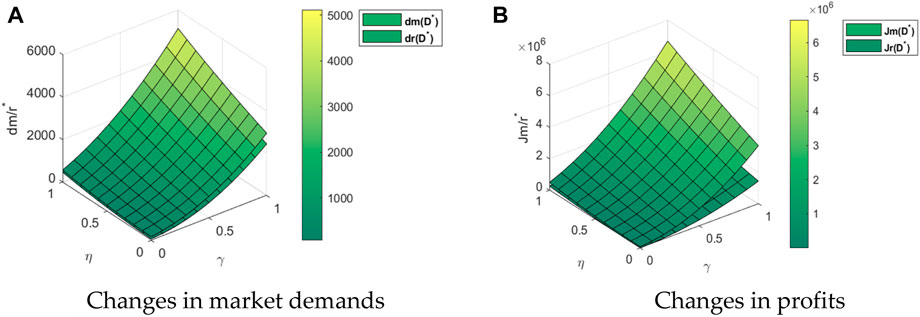
FIGURE 11. Impact of γ and η coefficients on market demand and profits. (A) Changes in market demands. (B) Changes in profits.
6 Conclusion
Under pressing global environmental issues, all businesses are obliged to work together to make the global transition to a low-carbon economy. In this study, a dynamic supply chain system consisting of a dual channel of green producers and merchants is constructed based on the investigation of the coordination contract of the low-carbon advertising competitive supply chain under the influence of low-carbon goodwill. Differential game theory is utilized to solve the low-carbon goodwill, market demand, and optimal value functions of producers and retailers for each of the four choice models. The impact of the competitive intensity of low-carbon advertisements on market demand and supply chain members’ profits is discussed using equilibrium strategy analysis and numerical examples, and the coordination effects of uni-directional and bi-directional cost-sharing contracts under low-carbon competitive conditions are further examined, and the following interesting conclusions are obtained: 1) under the low-carbon advertising invasion of the manufacturer’s direct marketing channel, the stronger advertising competition intensity between the manufacturer and retailer will stimulate both parties to invest more in low-carbon advertising efforts, and at the same time, it can lead to higher low-carbon goodwill of branded products, but such vicious competition is not beneficial to the supply chain members and the system, and both manufacturer’s and retailer’s profits will be damaged by the competition in the decentralized competition model. Meanwhile, brand preference and low-carbon preference have positive effects on market demand and the profit of manufacturers and retailers in the decentralized competition model. Therefore, in a healthy low-carbon competition, low-carbon supply chain members reaching a low-carbon cooperation contract is the best strategy to maintain a sustainable supply chain system. 2) In the decentralized model, the manufacturer’s market demand increases with the increase in advertising competition intensity, and the retailer’s market demand decreases with it, which indicates that the retailer does not possess the market advantage in the case of the manufacturer’s direct sales channel invasion of low-carbon advertising competition; there is a renunciation behavior, and the manufacturer has an absolute market advantage in advertising competition. Furthermore, the strength of this low-carbon advertising competition will be an important factor in the coordination of the manufacturer’s and the retailer’s strategic choices in the later stage of the process factors. At the same time, under the coordination of uni-directional cost-sharing contracts and bi-directional cost-sharing contracts, the channel market demand conflict in the supply chain can be gradually reduced and eventually improved to achieve stable win–win market demand. 3) Under the decision-making model of uni-directional and bi-directional cost-sharing contracts, the supply chain system can realize Pareto gains. The study shows that in the context of low-carbon advertising competition, both green manufacturers and retailers have the willingness to cooperate, and the allocation of advertising costs between manufacturers and retailers can stimulate both parties to invest in low-carbon advertising, gradually reduce the conflict of channel market demand in the supply chain, and ultimately realize perfection, which makes contractual decision-making more profitable than that of the supply chain members in the context of low-carbon advertising competition. Meanwhile, a bi-directional cost-sharing contract is superior to a uni-directional cost-sharing contract. 4) In terms of the coordination effect of contracts, the study found that entering into a contract under low-advertising competition intensity is more favorable to the profit growth of supply chain members, while entering into a contract under low-advertising competition intensity is more favorable to the profit of manufacturers and entering into a contract under strong competition is more favorable to the profit of retailers. Therefore, savvy green manufacturers should increase their cost share to promote cooperation with retailers under low-competition conditions. In practice, therefore, green manufacturers should proactively seize the opportunity of low-carbon competition by adjusting their low-carbon advertising cost share to retailers in order to promote advertising cooperation between the two parties and obtain optimal profit gains.
Through the research in this paper, the main contributions and management discussions are as follows:
(1) In the implementation of low-carbon economy, both manufacturers and retailers play important roles in the production and marketing of low-carbon products. For example, manufacturers break the constraints of traditional channels, open up online channels, and participate in low-carbon advertisements to further enhance the low-carbon goodwill of their products, which in turn promotes the sales of low-carbon products. This not only changes the passive role of manufacturers in the traditional supply chain to participate in low-carbon advertising cost sharing but also provides different decision-making references for manufacturers on how to position themselves in the low-carbon role in the supply chain. At the same time, it is also an in-depth exploration of the value of low-carbon advertising, as well as a further application and innovation of the traditional low-carbon goodwill model.
(2) Due to the impact of the epidemic and the rapid development of Internet, many manufacturers choose to open online direct sales channels to increase their market share as well as profits. Therefore, the focus on the low-carbon advertising competition scenario between manufacturers and retailers is of great practical value. It is worth reminding through the study that manufacturers should not only focus on their own benefits no matter which invasion strategy they adopt to gain access to the low-carbon competitive market but also actively carry out vertical cooperation while maintaining orderly and healthy competition, and low-carbon contractual cooperation under the healthy competition can enable both supply chain members to realize the optimal benefits. Therefore, supply chain members should strengthen the awareness of “win–win cooperation,” pay attention to the interests of supply chain partners while paying attention to their own benefits, treat partners as part of their own enterprises, and make “win–win” maximization only when the interests of partners are equal to their own interests.
(3) The traditional supply chain marketing model is difficult to promote the transformation of enterprises to green consumer-oriented production methods, resulting in a large loss of market demand, which not only harms the profit margin of enterprises themselves but also hinders the development process of greening the whole society. Therefore, in the face of consumers’ low-carbon consumption preference, forging the low-carbon competitive advantage of green manufacturing industry in the process of implementing carbon compliance and carbon neutral target tasks, comprehensively analyzing the supply chain coordination strategy under low-carbon advertisement competition not only provides low-carbon strategy options for supply chain members but also provides a theoretical basis for the sustainable development of low-carbon supply chain.
In this paper, we analyze dynamic optimization strategies and design coordination contracts for the low-carbon advertising intrusion supply chain of a green manufacturer in a low-carbon environment, without taking into account the influence of government subsidies and carbon emission policies on supply chain members’ decisions. As a result, in future research, we can include policy limitations to create a more comprehensive supply chain coordination contract that is worth studying.
The model proof process in Section 4 is similar to that in Section 3.
Data availability statement
The original contributions presented in the study are included in the article/Supplementary Material; further inquiries can be directed to the corresponding author.
Author contributions
D-rX: methodology, software, and writing–original draft. QQ: data curation, investigation, project administration, and writing-review and editing. J-mX: funding acquisition, supervision, and writing–review and editing. X-jH: project administration, and writing–review and editing. M-tJ: conceptualization, formal analysis, investigation.
Funding
The author(s) declare that financial support was received for the research, authorship, and/or publication of this article. This work was supported by the National Social Science Foundation (23XGL028).
Acknowledgments
The authors would like to express their sincere appreciation to the editors and reviewers for their suggestions and comments.
Conflict of interest
The authors declare that the research was conducted in the absence of any commercial or financial relationships that could be construed as a potential conflict of interest.
Publisher’s note
All claims expressed in this article are solely those of the authors and do not necessarily represent those of their affiliated organizations, or those of the publisher, the editors, and the reviewers. Any product that may be evaluated in this article, or claim that may be made by its manufacturer, is not guaranteed or endorsed by the publisher.
Supplementary material
The Supplementary Material for this article can be found online at: https://www.frontiersin.org/articles/10.3389/fenvs.2023.1260667/full#supplementary-material
References
Berger, P. D. (1973). Statistical decision analysis of cooperative advertising ventures. J. Operational Res. Soc. 24 (2), 207–216. doi:10.1057/jors.1973.38
Camilleri, A. R., Larrick, R. P., Hossain, S., and Patino-Echeverri, D. (2019). Consumers underestimate the emissions associated with food but are aided by labels. Nat. Clim. Change 9, 53–58. doi:10.1038/s41558-018-0354-z
Chang, S., Yue, J., Wang, X., and Yu, B. (2021). Managerial strategies for process innovation through the perspective of competition among supply chain members. J. Clean. Prod. 296, 126532. doi:10.1016/j.jclepro.2021.126532
Chen, T., Narasimhan, C., and Yoon, Y. (2017). Advertising and price competition in a manufacturer retai-ler channel. Int. J. Res. Mark. 34 (3), 694–716. doi:10.1016/j.ijresmar.2017.04.001
Chutani, A., and Sethi, S. P. (2018). Dynamic cooperative advertising under manufacturer and retailer level competition. Eur. J. Operational Res. 268 (2), 635–652. doi:10.1016/j.ejor.2018.02.027
Dhanapal, G., Gupta, D., and Prakash, A. (2023). Barriers and opportunities in achieving climate and sustainable development goals in India: a multilevel analysis. J. Integr. Environ. Sci. 20 (1), 1–16. doi:10.1080/1943815X.2022.2163665
Ghosh, D., and Shah, J. (2015). Supply chain analysis under green sensitive consumer demand and cost sharing contract. Int. J. Prod. Econ. 164, 319–329. doi:10.1016/j.ijpe.2014.11.005
Giovanni, P. D. (2010). Quality Improvement vs. Advertising support: which strategy works better for a manufacturer? Eur. J. Operational Res. 208 (2), 119–130. doi:10.1016/j.ejor.2010.08.003
He, L., Yuan, B., Bian, J., and Lai, k. (2021). Differential game theoretic analysis of the dynamic emission abatement in low-carbon supply chains. Ann. Operations Res. 324, 355–393. doi:10.1007/s10479-021-04134-9
He, P., He, Y., Shi, C., Xu, H., and Zhou, L. (2020). Cost-sharing contract design in a low-carbon service supply chain. Comput. Industrial Eng. 139, 106160. doi:10.1016/j.cie.2019.106160
Hong, Z., and Guo, X. (2019). Green product supply chain contracts considering environmental responsibilities. Omega 83, 155–166. doi:10.1016/j.omega.2018.02.010
Huang, X. (2023). Dynamic analysis of dual-market low-carbon supply chain: considering government intervention and joint promotion. J. Clean. Prod. 411, 137361. doi:10.1016/j.jclepro.2023.137361
Iea World Energy Outlook, (2021). IEA world energy outlook. https://www.iea.org/reports/world.
Kang, K., Zhao, Y., Zhang, J., and Qiang, C. (2019). Evolutionary game theoretic analysis on low-carbon strategy for supply chain enterprises. J. Clean. Prod. 230, 981–994. doi:10.1016/j.jclepro.2019.05.118
Karle, H., Peitz, M., and Reisinger, M. (2020). Segmentation versus agglomeration: competition between platforms with competitive sellers. J. Political Econ. 128 (6), 2329–2374. doi:10.1086/705720
Karray, S., and Herrán, M. G. (2021). The impact of a store brand introduction in a supply chain with competing manufacturers: the strategic role of pricing and advertising decision timing. Int. J. Prod. Econ. 244, 108378. doi:10.1016/j.ijpe.2021.108378
Kopalle, P. K., and Winer, R. S. (1996). A dynamic model of reference price and expected quality. Mark. Lett. 7, 41–52. doi:10.1007/bf00557310
Liang, L., and Li, F. (2020). Differential game modelling of joint carbon reduction strategy and contract coordination based on low-carbon reference of consumers. J. Clean. Prod. 277, 123798. doi:10.1016/j.jclepro.2020.123798
Liu, X., and Xu, H. (2022). Does low-carbon pilot city policy induce low-carbon choices in residents' living: holistic and single dual perspective. J. Environ. Manag. 324, 116353. doi:10.1016/j.jenvman.2022.116353
Ma, D., Hu, J., and Yao, F. (2020). Big data empowering low-carbon smart tourism study on low-carbon tourism O2O supply chain considering consumer behaviors and corporate altruistic preferences. Comput. Industrial Eng. 153 (3), 107061. doi:10.1016/j.cie.2020.107061
Magrinyà, F., Mercadé-Aloy, J., and Ruiz-Apiánez, B. (2023). Merging green and active transportation infrastructure towards an equitable accessibility to green areas: barcelona green axes. Land 12 (4), 919. doi:10.3390/land12040919
Martín-Herrán, G., and Sigué, S. P. (2017). An integrative framework of cooperative advertising: should manufacturers continuously support retailer advertising? J. Bus. Res. 70, 67–73. doi:10.1016/j.jbusres.2016.07.005
Nerlove, M., and Arrow, K. J. (1962). Optimal advertising policy under dynamic conditions. Economica 29 (114), 129–142. doi:10.2307/2551549
Pei, Z., Toombs, L., and Yan, R. (2014). How does the added new online channel impact the supporting advertising expenditure? J. Retail. Consumer Serv. 21 (3), 229–238. doi:10.1016/j.jretconser.2014.02.004
Pizarro-Irizar, C., Dingenen, R. V., Arto, I., González-Eguino, M., Markandya, A., Mulvaney, K. M., et al. (2020). Health co-benefits and mitigation costs as per the Paris Agreement under different technological pathways for energy supply. Environ. Int. 136, 105513. doi:10.1016/j.envint.2020.105513
Prasad, A., and Sethi, S. P. (2004). Competitive advertising under uncertainty: a stochastic differential game approach. J. Optim. Theory Appl. 123 (1), 163–185. doi:10.1023/b:jota.0000043996.62867.20
Roh, T., Noh, J., Oh, Y., and Park, K. S. (2022). Structural relationships of a firm's green strategies for environmental performance: the roles of green supply chain management and green marketing innovation. J. Clean. Prod. 356, 131877. doi:10.1016/j.jclepro.2022.131877
Sarkar, B., Omair, M., and Kim, N. (2020). A cooperative advertising collaboration policy in supply chain management under uncertain conditions. Appl. Soft Comput. 88, 105948. doi:10.1016/j.asoc.2019.105948
Sarti, S., Darnall, N., and Testa, F. (2018). Market segmentation of consumers based on their actual sustainability and health-related purchases. J. Clean. Prod. 192, 270–280. doi:10.1016/j.jclepro.2018.04.188
United Nations Environment Programme, (2022). Emissions gap report 2022: the closing window—climate crisis calls for rapid transformation of societies. No 9789280739794. Nairobi, Kenya: United Nations Environment Programme.
Willetts, L. (2022). Stockholm+50: what does it mean for global health? Lancet Planet. Health 6 (5), 388–390. doi:10.1016/S2542-5196(22)00100-0
Wu, H., Li, G., Zheng, H., and Zhang, X. (2022b). Contingent channel strategies for combating brand spillover in a co-opetitive supply chain. Transp. Res. Part E Logist. Transp. Rev. 164, 102830. doi:10.1016/j.tre.2022.102830
WuZha, X. Y., and Yu, Y. (2022a). Asymmetric retailers’ sales effort competition in the presence of a manufacturer’s help. Transp. Res. Part E Logist. Transp. Rev. 159, 102625. doi:10.1016/j.tre.2022.102625
Xiang, Z., and Xu, M. (2019). Dynamic cooperation strategies of the closed-loop supply chain involving the internet service platform. J. Clean. Prod. 220, 1180–1193. doi:10.1016/j.jclepro.2019.01.310
Xiao, D., Zhou, Y., Zhong, Y., and Xie, W. (2019). Optimal cooperative advertising and ordering policies for A two-echelon supply chain. Comput. Industrial Eng. 127, 511–519. doi:10.1016/j.cie.2018.10.038
Yang, H., Huang, X., Westervelt, D. M., Horowitz, L., and Peng, W. (2022). Socio-demographic factors shaping the future global health burden from air pollution. Nat. Sustain. 6, 58–68. doi:10.1038/s41893-022-00976-8
Yi, Y., Yang, M., Fu, C., and Li, Y. (2022). Gaming strategies within a green supply chain considering consumers’ concern about the greenness and conformance quality of products. Environ. Sci. Pollut. Res. 29, 69082–69100. doi:10.1007/s11356-022-20318-7
Yu, C., Wang, C., and Zhang, S. (2020). Advertising cooperation of dual-channel low-carbon supply chain based on cost-sharing. Kybernetes 49 (4), 1169–1195. doi:10.1108/K-04-2018-0205
Zaccour, G. (2008). On the coordination of dynamic marketing channels and two-part tariffs. Automatica 44 (5), 1233–1239. doi:10.1016/j.automatica.2007.10.009
Zhang, X., Jin, Y., and Shen, C. (2020). Manufacturers’ green investment in a competitive market with a common retailer. J. Clean. Prod. 276, 123164. doi:10.1016/j.jclepro.2020.123164
Zhang, Z., Song, H., Gu, X., Shi, V., and Zhu, J. (2021). How to compete with a supply chain partner: retailer's store brand vs. manufacturer's encroachment. Omega 103, 102412. doi:10.1016/j.omega.2021.102412
Zhong, Y., and Sun, H. (2022). Game theoretic analysis of prices and low-carbon strategy considering dual-fairness concerns and different competitive behaviours. Comput. Industrial Eng. 169, 108195. doi:10.1016/j.cie.2022.108195
Zhou, Y., Bao, M., Chen, X., and Xu, X. (2016). Co-op advertising and emission reduction cost sharing contracts and coordination in low-carbon supply chain based on fairness concerns. J. Clean. Prod. 133, 402–413. doi:10.1016/j.jclepro.2016.05.097
Keywords: green manufacturers, low-carbon goodwill, low-carbon advertising competition, contractual option, differential game
Citation: Xie D-r, Qin Q, Xie J-m, He X-j and Jiang M-t (2023) Coordination contracts and numerical analysis of low-carbon competitive supply chains under the influence of low-carbon goodwill. Front. Environ. Sci. 11:1260667. doi: 10.3389/fenvs.2023.1260667
Received: 18 July 2023; Accepted: 10 October 2023;
Published: 07 November 2023.
Edited by:
Pourya Pourhejazy, UiT The Arctic University of Norway, NorwayReviewed by:
Liang Yuan, China Three Gorges University, ChinaErfan Babaee Tirkolaee, University of Istinye, Türkiye
Copyright © 2023 Xie, Qin, Xie, He and Jiang. This is an open-access article distributed under the terms of the Creative Commons Attribution License (CC BY). The use, distribution or reproduction in other forums is permitted, provided the original author(s) and the copyright owner(s) are credited and that the original publication in this journal is cited, in accordance with accepted academic practice. No use, distribution or reproduction is permitted which does not comply with these terms.
*Correspondence: Jian-min Xie, eGllamlhbm1pbkBzd3VzdC5lZHUuY24=
 De-ru Xie
De-ru Xie Qin Qin1
Qin Qin1